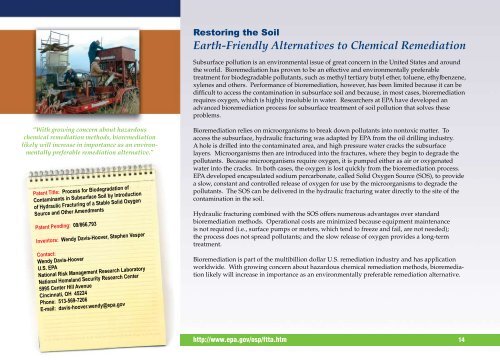FTTA Patent Catalog (PDF) - US Environmental Protection Agency
FTTA Patent Catalog (PDF) - US Environmental Protection Agency
FTTA Patent Catalog (PDF) - US Environmental Protection Agency
Create successful ePaper yourself
Turn your PDF publications into a flip-book with our unique Google optimized e-Paper software.
“With growing concern about hazardous<br />
chemical remediation methods, bioremediation<br />
likely will increase in importance as an environmentally<br />
preferable remediation alternative.”<br />
<strong>Patent</strong> Title: Process for Biodegradation of<br />
Contaminants in Subsurface Soil by Introduction<br />
of Hydraulic Fracturing of a Stable Solid Oxygen<br />
Source and Other Amendments<br />
<strong>Patent</strong> Pending: 09/866,793<br />
Inventors: Wendy Davis-Hoover, Stephen Vesper<br />
Contact:<br />
Wendy Davis-Hoover<br />
U.S. EPA<br />
National Risk Management Research Laboratory<br />
National Homeland Security Research Center<br />
5995 Center Hill Avenue<br />
Cincinnati, OH 45224<br />
Phone: 513-569-7206<br />
E-mail: davis-hoover.wendy@epa.gov<br />
Restoring the Soil<br />
Earth-Friendly Alternatives to Chemical Remediation<br />
Subsurface pollution is an environmental issue of great concern in the United States and around<br />
the world. Bioremediation has proven to be an effective and environmentally preferable<br />
treatment for biodegradable pollutants, such as methyl tertiary butyl ether, toluene, ethylbenzene,<br />
xylenes and others. Performance of bioremediation, however, has been limited because it can be<br />
difficult to access the contamination in subsurface soil and because, in most cases, bioremediation<br />
requires oxygen, which is highly insoluble in water. Researchers at EPA have developed an<br />
advanced bioremediation process for subsurface treatment of soil pollution that solves these<br />
problems.<br />
Bioremediation relies on microorganisms to break down pollutants into nontoxic matter. To<br />
access the subsurface, hydraulic fracturing was adapted by EPA from the oil drilling industry.<br />
A hole is drilled into the contaminated area, and high pressure water cracks the subsurface<br />
layers. Microorganisms then are introduced into the fractures, where they begin to degrade the<br />
pollutants. Because microorganisms require oxygen, it is pumped either as air or oxygenated<br />
water into the cracks. In both cases, the oxygen is lost quickly from the bioremediation process.<br />
EPA developed encapsulated sodium percarbonate, called Solid Oxygen Source (SOS), to provide<br />
a slow, constant and controlled release of oxygen for use by the microorganisms to degrade the<br />
pollutants. The SOS can be delivered in the hydraulic fracturing water directly to the site of the<br />
contamination in the soil.<br />
Hydraulic fracturing combined with the SOS offers numerous advantages over standard<br />
bioremediation methods. Operational costs are minimized because equipment maintenance<br />
is not required (i.e., surface pumps or meters, which tend to freeze and fail, are not needed);<br />
the process does not spread pollutants; and the slow release of oxygen provides a long-term<br />
treatment.<br />
Bioremediation is part of the multibillion dollar U.S. remediation industry and has application<br />
worldwide. With growing concern about hazardous chemical remediation methods, bioremediation<br />
likely will increase in importance as an environmentally preferable remediation alternative.<br />
http://www.epa.gov/osp/ftta.htm 14

















